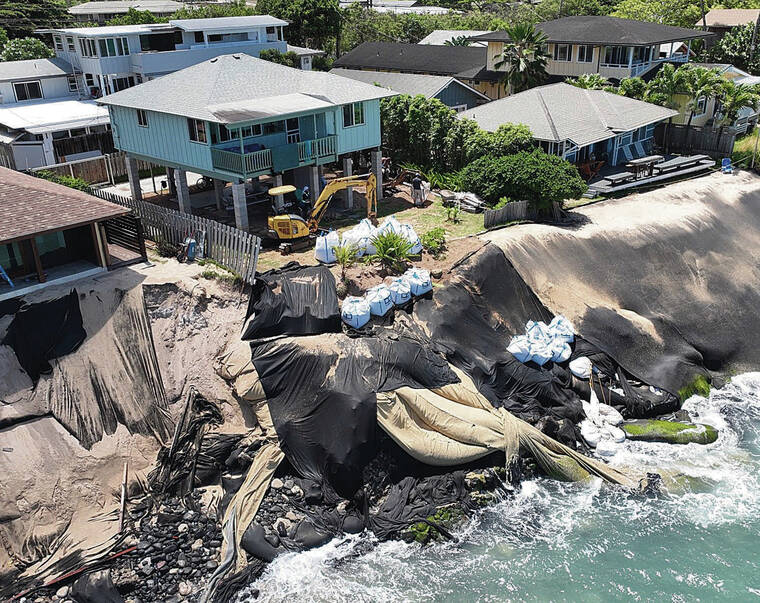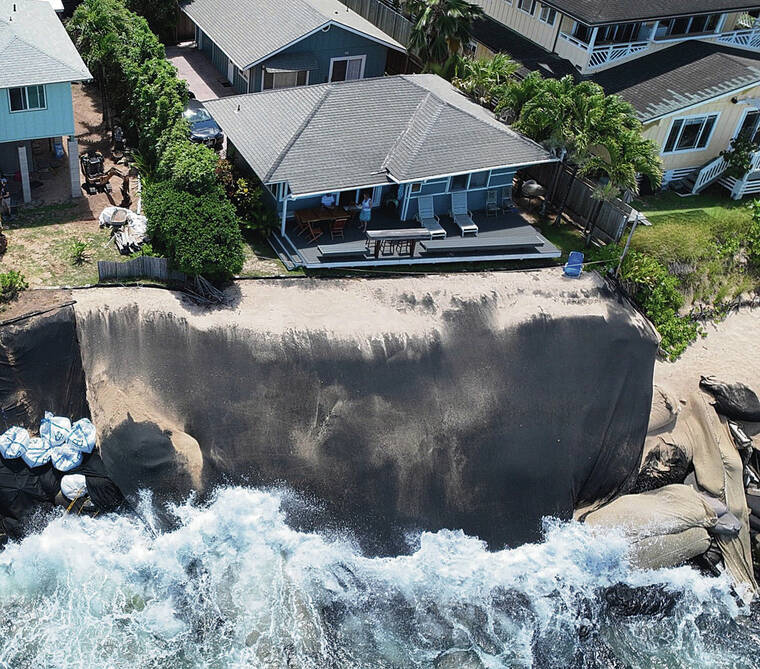An imperiled stretch of coastline between Sunset Beach and Rocky Point on Oahu’s famed North Shore has increasingly become a free-for-all as
owners of multimillion-dollar properties disregard Hawaii’s beach protection laws and scramble to save their homes from the unrelenting threat of powerful waves.
Despite strong prohibitions against armoring the shoreline, the owners of 59-175-B Ke Nui Road appear to have built a large rock seawall at their house in April and then covered it up with a lanai, a trove of drone shots released by the state Department of Land and Natural Resources this week shows.
Peter Rudisill, a California resident who purchased the property in 2019 with Kristjan Higdon, denied he had installed a rock wall. The Honolulu Star-Advertiser offered to send him the pictures, but Rudisill said he wanted to check with his attorney first.
Down the coastline at 59-149
Ke Nui Road, workers can be seen in aerial photos using a construction crane this month to drop large bags of an unknown material onto the shoreline in front of the home, some of which rolled down into the ocean.
DLNR’s Office of Conservation and Coastal Lands in 2021 sought to fine the property owner, Rodney Youman, a resident of New York, $32,000 for a separate offense of dropping dozens of rocks onto the beach. But the Board of Land and Natural Resources, which oversees DLNR, deferred the matter
after Youman told members that he had brought in an excavator to remove the rocks, though he conceded that contractors may not have been able to retrieve all of them because they were buried in 20 feet of sand.
The Land Board told OCCL staff to find out more about the rocks, but the matter was never brought back to the board.
Youman didn’t return a call seeking comment on the latest alleged violation.
Other swaths of this coastline of about 20 oceanfront homes in the Paumalu ahupuaa are covered with rocks and boulders that block the public beach. Along the shoreline fronting 59-155-E Ke Nui Road, dozens of rocks have been piled on the beach where portions of a failed pool
remain, while large boulders are stacked in front of
59-165-D Ke Nui Road and 59-165-B Ke Nui Road,
DLNR photos show.
Earlier this year Todd Dunphy, owner of 59-181-E and 59-181-F Ke Nui Road, brazenly admitted Opens in a new tab to employing an excavator to move massive amounts of sand to protect his homes.
The unauthorized work has played out amid a backdrop of expired “burritos,” the massive sand-filled tubes and heavy black tarps that have been placed on the public beach and become tangled heaps, spoiling what was once a stunning stretch of coastline.
In recent years DLNR gave property owners permission to erect the protections temporarily. But homeowners have refused to remove them after the permission expired. The dilapidated materials that get torn by the surf have attracted public outcry and the scrutiny of legislators, while DLNR has vowed not to approve any more.
Still, OCCL has caught property owners installing additional burritos without permission.
Michael Cain, who leads OCCL, says his small office has struggled to keep up with the dozens of shoreline violations. While OCCL has been slowly bringing enforcement actions against homeowners to the Land Board for approval, it’s a slow and frustrating process that often gets tied up in years-long legal battles as the shoreline hardening remains in place, damaging the state’s beaches.
Oahu has already lost about one-quarter of its beaches to shoreline hardening, and scientists warn that figure could rise to 40% by 2050. In order to survive, Hawaii’s beaches need to be able to migrate inland. If waves hit a hard barrier, the sandy beaches essentially drown.
Chip Fletcher, a coastal geologist at the University
of Hawaii at Manoa who has spent decades studying Hawaii’s coastlines, said the lack of enforcement along one of the island’s most treasured beaches is alarming. He called on Hawaii’s attorney general to take a more active role.
“Have we entered a new era, which is a crisis of enforcement?” asked Fletcher. “It’s quite significant that this beautiful beach can be so easily be destroyed without penalty.”
Enforcement of shoreline laws also can become bogged down as the state and county sort out jurisdictional boundaries. For example, OCCL said that it alerted Honolulu’s Department of Planning and Permitting
earlier this year of the construction taking place at
59-175-B Ke Nui Road, where drone shots captured rocks being stacked under the deck.
DPP issued a notice of violation in July, well after the work had begun, but has yet to levy fines.
DPP’s acting director, Dawn Apuna, didn’t respond to interview requests or written questions this week about the alleged violation.
Fletcher said it may be time to replace the bifurcated regulatory system with a single agency that is responsible for all aspects of beach management.
“Folks that I talk to have referred to that stretch of shoreline as the Wild West when it comes to coastal zone management, and it raises the question, Is there a better government approach?” said Fletcher.
Cain said the homes along this stretch of the North Shore might survive another winter season, but the situation remains unpredictable.
The “shoreline is very
dynamic, and the patterns
of sand accumulation vary depending on the direction of the swells in the summer and in the winter, as well as on how high our high tides are,” he said in video released to the news media this week. “So it’s impossible for us to predict what this winter will bring.”
Typically, the beach along this stretch widens during the winter months before narrowing once again in the summer, renewing the threat to homes.
“One of our goals in releasing the drone footage is to get higher-level attention to the issues, particularly at Paumalu,” said Cain. “So what I’m hoping to see this coming year is more executive-level and more legislative-level
attention and assistance.”
Hawaii’s top officials have been conspicuously silent, even as homes teeter along sand berms, threatening the safety of occupants and the public. One of the homes collapsed onto the beach in February, but Gov. David Ige and Honolulu Mayor Rick Blangiardi seemed reticent to address the problem.
At the time, a spokesperson for Blangiardi said the mayor was too busy for an interview to discuss what, if anything, the city was doing to do to address the growing disaster unfolding along the popular shoreline.
The Star-Advertiser sent some of the latest drone footage to Ige and Blangiardi on Thursday and sought interviews to discuss the situation. Blangiardi again said he was too busy for an interview.
Asked whether there were any discussions at the city level about potential condemnation proceedings
or a disaster declaration, Blangiardi’s communications director, Scott Humber, said the mayor’s office was not aware of any.
Ige didn’t respond to an interview request. The state Department of the Attorney General said it continues to work on enforcement actions with OCCL.




